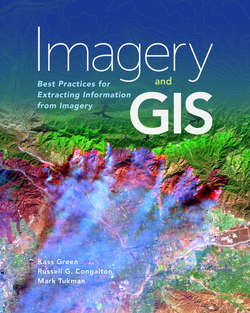Читать книгу Imagery and GIS - Kass Green - Страница 43
На сайте Литреса книга снята с продажи.
Altitude
ОглавлениеAltitude is an object’s height above sea level. The altitude of a remote sensing platform can vary between below sea level (in bathymetric projects) to more than 20,000 miles above sea level. Remote sensing platforms are classed into three types based on their range of distance from the earth:
1 1.Terrestrial and marine platforms, including elevated work platforms, mobile vehicles, buildings and towers, lampposts, buoys, boats, and humans.
2 2.Airborne platforms including UASs, fixed-wing aircraft, helicopters, and balloons.
3 3.Spaceborne platforms, which are either geostationary or orbit the earth.
Terrestrial platforms operate from beneath the ocean to the highest buildings on earth and may be fixed (e.g., ATM video cameras) or mobile (e.g., cars and boats). Airborne platforms fly within the earth’s atmosphere up to an altitude of typically 9.5 miles (15.3 kilometers) and include fixed-wing aircraft, UASs, helicopters, and balloons. Fixed-wing aircraft are the most common type of remote sensing platform and are used by many private companies and governments for imaging purposes. High-altitude piloted aircraft platforms have pressurized cabins, enabling them to fly as high as 50,000 feet above sea level. Low-altitude piloted aircraft platforms operate at altitudes up to 30,000 feet (5.7 miles), but are generally used to collect data at lower elevations to gain higher spatial resolution. The hovering ability of helicopters (below 500 feet and up to 12,500 feet) allows them to collect imagery at lower speeds than fixed-wing aircraft. Balloons have a wide range of achievable altitudes, from as low as needed for a tethered balloon to around 20 km or more for a blimp. UASs can be fixed- or rotor-winged with altitudes ranging from very close to the ground to very high in the air.
At the highest altitudes, earth observation satellites carry remote sensors around the earth in orbit at altitudes ranging from 100 to over 22,000 miles above sea level. Maintaining orbital altitude is a constant requirement for satellites because of the earth’s steady gravitational pull and atmospheric drag. Lower satellites must travel at higher velocities because they experience greater gravitational pull than satellites at higher altitudes. Thus, maintaining orbit requires a constant balance between gravity and the satellite’s velocity. Satellites with fuel onboard maintain their orbital altitude by using the fuel to maintain their velocities. However, at some point all satellites fall back to earth and burn up in the atmosphere, usually in controlled descents.
